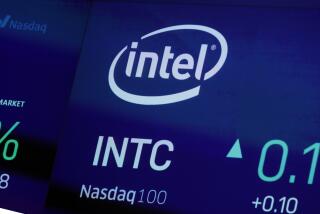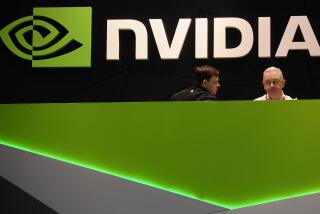At the Core of AMD, a Man Made for a Challenge
- Share via
AUSTIN, Texas — By now, after 60 years, Hector Ruiz has grown accustomed to surprising people.
There were the Texas high school teachers watching a Mexican kid who didn’t speak English until the 10th grade graduate as valedictorian -- on his way to earn a PhD.
For the record:
12:00 a.m. July 7, 2006 For The Record
Los Angeles Times Friday July 07, 2006 Home Edition Main News Part A Page 2 National Desk 1 inches; 60 words Type of Material: Correction
AMD executive: An article in Sunday’s Business section about Hector Ruiz, chief executive of Advanced Micro Devices Inc., said rival Intel Corp. sold chips with features measuring 65-millionths of a meter, compared with AMD’s current standard of 90 nanometers. A nanometer is a billionth of a meter, and the reference to Intel’s chips should have read 65-billionths of a meter.
Now, as the electric-guitar-playing chairman and chief executive of Advanced Micro Devices Inc., Ruiz is wowing the technology industry and Wall Street as he guides a perennial also-ran chip company in mounting a serious challenge to global titan Intel Corp.
In the four years since Ruiz took control of AMD, the son of a livestock manager and a secretary has increased the company’s global market share in computer microprocessors to 21% -- up from 17% last year -- and eroded Intel’s longtime dominance. In product lines such as server processors, experts say AMD leads its archrival in technical performance.
This year, in a sign of AMD’s momentum, world PC leader Dell Inc. agreed to use the company’s chips in its machines for the first time. AMD’s revenue rose to $5.85 billion in 2005 from $2.7 billion in 2002, when Ruiz became chief executive. At the same time, the company’s bottom line improved from a loss of $1.3 billion to a profit of $165.5 million. AMD’s stock price -- although well off its recent high of $42.70 -- has climbed nearly sevenfold from its 2002 low of $3.51.
Ruiz has “turned out to be a pretty amazing guy,” said Dan Hutcheson, chief executive of VLSI Research, a San Jose semiconductor industry tracker.
“When he first became CEO, people were taking bets on how long he would last.”
That doesn’t surprise Ruiz. People have bet against him for a long time.
He grew up in Piedras Negras, Mexico, just across the border from Eagle Pass, Texas. Like many boys there he shined shoes in the city’s public square. He had four younger sisters and was his grandparents’ only grandson. He admits to being spoiled but got along well with his sisters, all of whom became teachers.
“All I can remember from my childhood is that it was a great childhood,” he recalled.
He got to know Olive Givin, an American Methodist missionary who lived nearby and gave the teenager a job running errands. Givin tutored the youth in English and suggested he attend high school in the United States.
So with the local Rotary Club paying his fees and tuition, Ruiz walked across the border each day to attend Eagle Pass High School. He struggled with English and spent many after-school hours with chemistry, geometry and physics teachers to master the subjects.
Ruiz graduated as class valedictorian and went on to the University of Texas. Givin funded his first year there.
An interest in auto mechanics led him to mechanical engineering, where he discovered a passion for electronics. He earned bachelor’s and master’s degrees in electrical engineering and later obtained a doctorate in electronics from Rice University.
After college, Ruiz joined Texas Instruments Inc. in 1972 and was part of the team that worked on the first single-chip calculator. He moved to Motorola Corp. in 1977, eventually becoming head of the semiconductor product group.
“Hector is generally a soft-spoken, people-oriented person,” said Gary Tooker, who was chief executive and chairman of Motorola during six of Ruiz’s last seven years there. “This is not to say he wasn’t forceful and didn’t have opinions, but his management style was flexible enough to fit the occasion.”
As a young engineer, Ruiz picked up an interest in biking and playing the electric guitar, on which he’s been known to riff at corporate meetings. AMD also sponsors concerts, and Ruiz has an assortment of guitars in his office today, including one autographed by Dweezil Zappa.
Motorola and AMD had a joint development program, which brought Ruiz to the attention of AMD founder Jerry Sanders, who recruited Ruiz in 2000 to be president and chief operating officer. When Sanders retired as chief executive in 2002, Ruiz took the top job. He became chairman in 2004.
Ruiz’s hiring surprised some analysts, who doubted that he could make an effective transition from Motorola’s confrontational culture to AMD’s more collaborative approach.
Sanders founded AMD in 1969 as a second-source provider of circuit board components. In the 1970s, it produced Inteldesigned processors, obtaining patent licenses to produce clones of Intel chips. After a dispute over technology sharing, AMD struck out on its own, carving out a solid niche as a less expensive alternative to Intel.
“Nobody believed that someone from Motorola could make it at AMD,” Hutcheson said. “People didn’t think it would work, but it turned out to be very beneficial because he fixed many things without making it a slower company.”
For example, Ruiz presided over the spin-off of AMD’s memory chip business, and he guided the construction and opening of a fabrication plant in Germany and its smooth ramping up to volume production, a process prone to hiccups. He has pushed the well-received Opteron server chip and the company’s move to 64-bit computing -- the leading edge in data processing capacity.
Although the company is based in Sunnyvale, Calif., Ruiz lives in Austin, Texas, and works out of an office in an industrial park close to the airport there.
In shirt sleeves and no necktie during a recent interview, he spoke of the tough two-horse race with Intel.
“I think creating technology for technology’s sake and then trying to cram it down people’s throats is of limited potential,” Ruiz said. “If you’re the only supplier in town, there’s no choice. But now, hopefully, we’re becoming a viable choice -- a viable alternative -- so people don’t have to allow something to be crammed down their throat.”
Intel, not surprisingly, takes exception to that characterization.
“That’s somebody’s marketing spin on our business,” said Intel spokesman Chuck Mulloy. “We’ve got a very successful company by understanding technology that works well with our customers and the ecosystems around the world -- chipset makers, large computer makers, [sales] channel members. The customer-centric marketing claims that AMD makes are not exclusive to them or anyone else.”
Still, Ruiz has impressed analysts with chips targeted at specific audiences, such as the entry-level Turion processor for cheaper PCs and the fast, high-performance Athlon chip for gaming enthusiasts.
“AMD under Jerry Sanders was very sales driven, to sell what they had by whatever they had to do,” said Dean McCarron of Mercury Research in Cave Creek, Ariz., which specializes in semiconductors. “AMD under Hector seems to be more market focused, where they’ve developed products for specific market needs.”
AMD has capitalized on some Intel stumbles, notably the latter’s Itanium processor. The 64-bit chip for servers processes twice as much information at a time as 32-bit chips but is incompatible with 32-bit software. Customers were faced with having to purchase new programs. AMD, on the other hand, saw an opening and developed the Opteron processor, which runs both 64-bit and 32-bit code.
“We believed the industry was really going down a rathole after Itanium,” Ruiz said, echoing the criticism of customers who balked at being forced to adopt 64-bit servers and buy new software. “Turns out we were right.”
Intel’s missteps have given Ruiz and AMD a window they might not have had otherwise.
From the first quarter of last year to the first quarter of this year, Intel’s worldwide share of the processor market fell to 74.3% from 81.6%. In the highly profitable server market, Intel’s drop has been more dramatic, declining to 78% of its market segment this year from 95% two years ago, according to Mercury Research.
“They clearly took [technical] leadership in the server segment, but we’re not done and it’s not over,” Intel spokesman Mulloy said.
He noted that just last week Intel introduced the Xeon server chip based on a new architecture and that the company’s desktop and laptop processors based on a cutting-edge 65-nanometer manufacturing process are due this summer, about six months ahead of AMD.
AMD got a boost in March, when Dell said it would acquire Alienware, a big AMD customer that specializes in high-end gaming machines.
In May, there was bigger news. Dell announced it would use AMD processors for the first time in a Dell product: a high-end, four-processor server. Dell Chief Executive Kevin Rollins said at the time that although the deal covered only a small part of Dell’s business, it was what customers wanted.
Analysts caution that Ruiz must keep pace with Intel’s advances in “multi-core” technology, in which more than one computing engines are built into processors, and in designing ever-tinier features in silicon, accelerating the devices’ power and efficiency.
Currently, Intel sells chips with features measuring 65 millionths of a meter, while AMD markets products built at the 90-nanometer level.
But the biggest challenge -- by Ruiz’s admission and analysts’ estimation -- is to garner a larger share of the profitable “enterprise” market: large corporations, universities and government agencies.
“AMD has a very, very low share of corporate customers,” noted Nathan Brookwood of semiconductor consulting firm Insight 64.
“But now that they’ve achieved a certain credibility in servers, I think we’ll see that rub off and more corporate IT managers opt for AMD.”
Ruiz will tell you that AMD has only begun.
He’s set his sights on 30% of the world microprocessor market -- a hefty inroad compared with the 10% it owned 10 years ago.
“That’s a milestone that we think we can get to in the next three years,” Ruiz said. “We don’t want to give ourselves that as a goal; it kind of self-limits you to that. We think of it as a milestone.”






